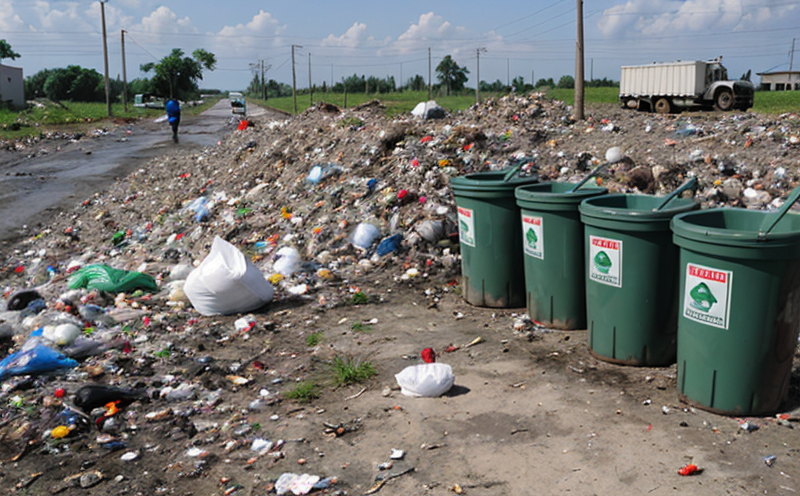EPA 8260 Volatile Organic Compounds VOC in Solid Waste Test
The EPA (Environmental Protection Agency) Method 8260 is a standardized protocol used to analyze volatile organic compounds (VOCs) found in solid waste. This method is critical for environmental testing laboratories as it ensures compliance with regulatory standards and provides reliable data on the presence of VOCs, which are chemicals that vaporize at or below room temperature.
Understanding VOCs is essential because they can have significant impacts on human health and the environment. These compounds include solvents like benzene, toluene, xylenes, and styrene, among others. The EPA 8260 test helps identify these compounds in solid waste streams, which could be from industrial byproducts, household trash, or other sources.
The significance of this testing lies in the need for proper disposal methods to prevent VOCs from contaminating soil, groundwater, and air. By using EPA Method 8260, facilities can ensure they are meeting regulatory requirements set forth by environmental protection agencies around the world. This method also supports research into waste management practices and helps inform policy decisions related to solid waste.
To perform this test accurately, it is crucial to follow a strict procedure outlined in the EPA's guidelines. Specimens must be prepared carefully according to specific protocols, including sample collection, storage, transportation, and preservation methods. Once collected, samples undergo rigorous analysis using advanced analytical instruments such as gas chromatography-mass spectrometry (GC-MS).
The results from this testing help facilities understand the composition of their solid waste streams better, allowing them to make informed decisions about how they manage these materials going forward. Compliance with EPA regulations ensures that industries are contributing positively to environmental sustainability efforts.
Scope and Methodology
| Step | Description |
|---|---|
| Sample Collection | Collection of representative samples from solid waste streams, ensuring no contamination occurs during the process. |
| Preservation and Transportation | Storage in appropriate containers with desiccants to prevent moisture absorption, followed by secure transportation to the testing facility. |
| Preparation for Analysis | Grinding samples if necessary, then extracting VOCs using solvent-based techniques or headspace methods. |
| Instrumental Analysis | Analyzing extracted compounds via GC-MS to identify and quantify VOCs present in the sample. |
The EPA Method 8260 specifies that samples should be stored at room temperature prior to analysis, which helps maintain the integrity of the sample. Additionally, it requires that all equipment used for this testing adheres strictly to manufacturer instructions and undergoes regular calibration checks.
Upon completing the test, results are reported according to specified formats provided by the EPA. These reports typically include detailed information about the types and quantities of VOCs detected in the solid waste sample. This data is valuable not only for regulatory compliance but also for internal quality control measures within facilities.
Customer Impact and Satisfaction
- Regulatory Compliance: Meeting stringent EPA standards ensures that clients remain compliant with environmental regulations, avoiding potential fines or legal action.
- Risk Management: Identifying VOCs early allows for proactive measures to be taken regarding waste management practices and disposal methods.
Clients who utilize our EPA Method 8260 testing service can rest assured knowing that they are taking steps towards a more sustainable future. By adhering to these testing protocols, organizations demonstrate their commitment to environmental responsibility, which is increasingly important as public awareness grows regarding the impact of human activities on nature.
Our clients appreciate the detailed reports we provide, which give them clear insights into their waste composition and help guide decision-making processes related to resource recovery or disposal. This level of transparency fosters trust between us and our customers, ultimately enhancing overall satisfaction with the service offered.
Use Cases and Application Examples
- Industrial Waste Management: Companies involved in manufacturing processes often generate waste containing various VOCs. Using EPA Method 8260 allows them to assess the extent of contamination before deciding on appropriate treatment methods.
- Hazardous Waste Handling: When dealing with hazardous materials, accurate identification of VOCs is crucial for ensuring safe handling and disposal practices are followed.
In both scenarios above, understanding the specific types and concentrations of VOCs present enables better informed choices regarding waste management strategies. For instance, some VOCs may be suitable for recycling while others might require more stringent disposal procedures due to their toxicity or persistence in the environment.
Another application involves academic research institutions studying environmental impacts caused by different types of solid waste. By applying EPA Method 8260 during these studies, researchers gain valuable data that contributes to advancing knowledge about pollution sources and mitigation techniques.





